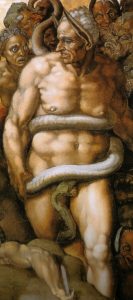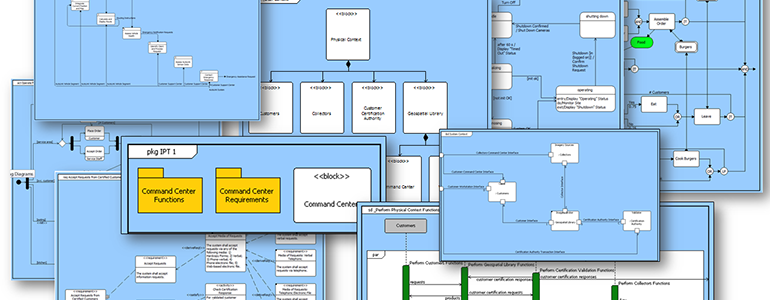The choice of representations in model-based systems engineering (MBSE) turns on the needs of the audience for understanding. The purpose of communication is to express the ideas of the sender in a way that produces a common understanding between the sender and the receiver. Those versed in communication know achieving that understanding begins with the background and context of the audience rather than the preferences or desires of the sender.
 This challenge is not unique to 21st century systems engineers. Across disciplines and even centuries, artists, scientists, policy makers, and others have shared in the need for efficient and effective communication of their ideas. Having completed the ceiling frescoes in the Sistine Chapel as a young artist, a 61-year-old Michelangelo was summoned by Pope Paul III to paint the altar wall of the Chapel. The painting was to become a depiction of the Last Judgment. As Michelangelo decorated the wall in fresco, the Papal Master of Ceremonies, a man named Biagio da Cesena, complained to the Pope regarding the nude figures depicted in the painting. He argued that “…it was mostly disgraceful that in so sacred a place there should have been depicted all those nude figures, exposing themselves so shamefully,” and called the painting more suitable to “the public baths and taverns.” Michelangelo responded by painting Biagio into the scene at the gates of Hell as the mythical Minos, the Judge of the Damned – naked, of course, and wrapped only in a snake. Adding insult to injury, Michelangelo gave him the ears of a donkey, the painter’s symbol that the figure depicted was a fool.
This challenge is not unique to 21st century systems engineers. Across disciplines and even centuries, artists, scientists, policy makers, and others have shared in the need for efficient and effective communication of their ideas. Having completed the ceiling frescoes in the Sistine Chapel as a young artist, a 61-year-old Michelangelo was summoned by Pope Paul III to paint the altar wall of the Chapel. The painting was to become a depiction of the Last Judgment. As Michelangelo decorated the wall in fresco, the Papal Master of Ceremonies, a man named Biagio da Cesena, complained to the Pope regarding the nude figures depicted in the painting. He argued that “…it was mostly disgraceful that in so sacred a place there should have been depicted all those nude figures, exposing themselves so shamefully,” and called the painting more suitable to “the public baths and taverns.” Michelangelo responded by painting Biagio into the scene at the gates of Hell as the mythical Minos, the Judge of the Damned – naked, of course, and wrapped only in a snake. Adding insult to injury, Michelangelo gave him the ears of a donkey, the painter’s symbol that the figure depicted was a fool.
Biagio complained to the Pope about this pictorial affront to his dignity. The Pope is said to have replied that he could do nothing to remove Biagio from the scene as his jurisdiction did not extend to Hell.
Michelangelo intended to hold Biagio up to public ridicule. The success of his efforts depended on the fact that his audience, 16th century Rome, would recognize Biagio, know who Minos was and what his role entailed, and recognize where Biagio was depicted to be. But this thinly veiled insult is largely meaningless in our world where we lack the personal knowledge of Biagio and the mythological literacy on which Michelangelo rested his insult. For us, the figure that so incensed Biagio is simply anonymous.
If we fail to exercise care and forethought as we select our system design representations, our intended message can suffer the same fate. If the view we choose fails to resonate with our audience, then our message will be lost. Software-oriented views shown to a software-oriented audience may prove quite effective. Those same views shown to a process-oriented audience will lose much, if not all, of their ability to convey our thoughts.
Systems engineering has a broad palette of representational choices and a broad range of audiences for our message. We can – and should – use many different views to depict our designs. The choice of a view turns on two situational factors that we use to narrow the field of alternatives:
- Does the view convey the information we want to the audience? In any given situation, several views may fit this criterion. For example, activity diagrams, enhanced functional flow block diagrams (EFFBDs), and sequence diagrams all track the passage of control through a functional process where internal block diagrams would not.
- The second, and critical, question calls for a knowledge of the intended audience. An audience of process improvement practitioners may respond best to the EFFBD while a group of software developers might identify more readily with the activity diagram.
Making a good choice here prevents the difficulty that we, as 21st century people, experience with Michelangelo’s Minos/Biagio message. For us, the information is there in the painting, but we don’t “get it” without an external explanation. The information desired under factor 1 is present, but factor 2 is unanswered for us.
If we choose a sub-optimal representation for a given audience, we make additional external explanation necessary. Our message may be lost. Michelangelo’s feelings about Biagio are there on the altar wall, but they are lost to us without some “help” in understanding his way of communicating them. At best, that is a loss of efficiency and at worst a total loss of the message. Neither of these conditions is acceptable for our projects.
Obviously, the richer the palette of choices, the more likely we are to be able to satisfy our quest to communicate our ideas. Like a large vocabulary, a wide range of choices in views makes us more articulate. There are some who seek to standardize our communication to a finite range of views. This worthy effort addresses the precision of our communication. But, while the reduction of ambiguity is a useful goal, we must be careful not to limit our communication to a narrow audience composed of those who subscribe to the standards.
The secret to effective systems engineering communication is a broad range of choices that can be narrowed to those that fit the situation at hand. Anything less deprives us of our ability to “make our points,” and assigns our message the same fate as that of Michelangelo’s disdain for Biagio.





